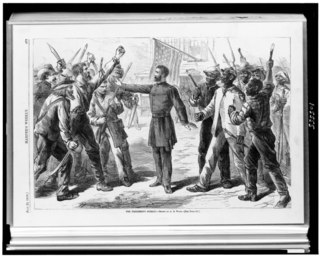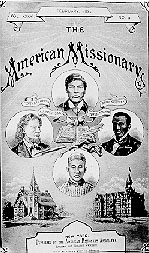
The Emancipation Proclamation, officially Proclamation 95, was a presidential proclamation and executive order issued by United States President Abraham Lincoln on January 1, 1863, during the American Civil War. The Proclamation had the effect of changing the legal status of more than 3.5 million enslaved African Americans in the secessionist Confederate states from enslaved to free. As soon as slaves escaped the control of their enslavers, either by fleeing to Union lines or through the advance of federal troops, they were permanently free. In addition, the Proclamation allowed for former slaves to "be received into the armed service of the United States". The Emancipation Proclamation played a significant part in the end of slavery in the United States.

Booker Taliaferro Washington was an American educator, author, and orator. Between 1890 and 1915, Washington was the primary leader in the African-American community and of the contemporary Black elite.

Hampton is an independent city in the Commonwealth of Virginia in the United States. The population was 137,148 as of the 2020 census, making it the seventh-most populous city in Virginia. Hampton is included in the Hampton Roads metropolitan area, the 37th-largest in the United States, with a total population of 1,799,674 in 2020. This area, known as "America's First Region", also includes the independent cities of Chesapeake, Virginia Beach, Newport News, Norfolk, Portsmouth, and Suffolk, as well as other smaller cities, counties, and towns of Hampton Roads.

Tuskegee University is a private, historically black land-grant university in Tuskegee, Alabama. It was founded on July 4th in 1881 by the Alabama Legislature.

The Bureau of Refugees, Freedmen, and Abandoned Lands, usually referred to as simply the Freedmen's Bureau, was a U.S. government agency of early post American Civil War Reconstruction, assisting freedmen in the South. It was established on March 3, 1865, and operated briefly as a federal agency after the War, from 1865 to 1872, to direct provisions, clothing, and fuel for the immediate and temporary shelter and supply of destitute and suffering refugees and freedmen and their wives and children.

Samuel Chapman Armstrong was an American soldier and general during the American Civil War who later became an educator, particularly of non-whites. The son of missionaries in Hawaii, he rose through the Union Army during the American Civil War to become a general, leading units of Black American soldiers. He became best known as an educator, founding and becoming the first principal of the normal school for Black American and later Native American pupils in Virginia which later became Hampton University. He also founded the university's museum, the Hampton University Museum, which is the oldest Black American museum in the country, and the oldest museum in Virginia.

Hampton University is a private, historically black, research university in Hampton, Virginia. Founded in 1868 as Hampton Agricultural and Industrial School, it was established by Black and White leaders of the American Missionary Association after the American Civil War to provide education to freedmen. The campus houses the Hampton University Museum, which is the oldest museum of the African diaspora in the United States and the oldest museum in the commonwealth of Virginia. First led by former Union General Samuel Chapman Armstrong, Hampton University's main campus is located on 314 acres in Hampton, Virginia, on the banks of the Hampton River.

Fort Monroe is a former military installation in Hampton, Virginia, at Old Point Comfort, the southern tip of the Virginia Peninsula, United States. It is currently managed by partnership between the Fort Monroe Authority for the Commonwealth of Virginia, the National Park Service, and the city of Hampton as the Fort Monroe National Monument. Along with Fort Wool, Fort Monroe originally guarded the navigation channel between the Chesapeake Bay and Hampton Roads—the natural roadstead at the confluence of the Elizabeth, the Nansemond and the James rivers.

Phoebus is a formerly incorporated town now part of the present-day city of Hampton, Virginia, on the Virginia Peninsula. In 1900, it was named in honor of local businessman Harrison Phoebus (1840–1886), who is credited with convincing the Chesapeake and Ohio Railway (C&O) to extend its tracks to the town from Newport News.

Mary Smith Peake, born Mary Smith Kelsey, was an American teacher, humanitarian and a member of the black elite in Hampton, best known for starting a school for the children of former slaves starting in the fall of 1861 under what became known as the Emancipation Oak tree in present-day Hampton, Virginia near Fort Monroe. The first teacher hired by the American Missionary Association, she was also associated with its later founding of Hampton University in 1868.

The American Missionary Association (AMA) was a Protestant-based abolitionist group founded on September 3, 1846 in Albany, New York. The main purpose of the organization was abolition of slavery, education of African Americans, promotion of racial equality, and spreading Christian values. Its members and leaders were of both races; the Association was chiefly sponsored by the Congregationalist churches in New England. The main goals were to abolish slavery, provide education to African Americans, and promote racial equality for free Blacks. The AMA played a significant role in several key historical events and movements, including the Civil War, Reconstruction, and the Civil Rights Movement.

Contraband was a term commonly used in the US military during the American Civil War to describe a new status for certain people who escaped slavery or those who affiliated with Union forces. In August 1861, the Union Army and the US Congress determined that the US would no longer return people who escaped slavery who went to Union lines, but they would be classified as "contraband of war," or captured enemy property. They used many as laborers to support Union efforts and soon began to pay wages.
The Grand Contraband Camp was located in Elizabeth City County, Virginia, on the Virginia Peninsula near Fort Monroe, during and immediately after the American Civil War. The area was a refuge for escaped slaves who the Union forces refused to return to their former Confederate masters, by defining them as "contraband of war". The Grand Contraband Camp was the first self-contained black community in the United States and occupied the area of the downtown section of the present-day independent city of Hampton, Virginia.

Beulah Baptist Church is a predominantly Black Baptist Church at 320 S. Washington Street in Old Town Alexandria, Virginia. The historic building is a two-story brick structure with a gable roof and large stained glass window. Built in 1863, it was sandwiched between the two Black neighborhoods of 'the Hill' and 'the Bottoms'. The church was added to the National Register of Historic Places in 2004.

Camp Nelson National Monument, formerly the Camp Nelson Civil War Heritage Park, is a 525-acre (2.12 km2) national monument, historical museum and park located in southern Jessamine County, Kentucky, United States, 20 miles (32 km) south of Lexington, Kentucky. The American Civil War era camp was established in 1863 as a depot for the Union Army during the Civil War. It became a recruiting ground for new soldiers from Eastern Tennessee and enslaved people, many of whom had fled their living conditions to be soldiers.

The history of Hampton Roads dates to 1607, when Jamestown was founded. Two wars have taken place in addition to many other historical events.

The 140th Anniversary Celebration of the Emancipation Proclamation was a national campaign to honor, celebrate, and commemorate January 1, 2003, as the 140th anniversary of the signing of the Emancipation Proclamation on January 1, 1863, by United States President Abraham Lincoln.
The Freedmen's Colony of Roanoke Island, also known as the Roanoke Island Freedmen's Colony, or "Freedman's Colony", was founded in 1863 during the Civil War after Union Major General John G. Foster, Commander of the 18th Army Corps, captured the Confederate fortifications on Roanoke Island off North Carolina in 1862. He classified the slaves living there as "contraband", following the precedent of General Benjamin Butler at Fort Monroe in 1861, and did not return them to Confederate slaveholders. In 1863, by the Emancipation Proclamation, all slaves in Union-occupied territories were freed.

Adella Hunt Logan was an African-American writer, educator, administrator and suffragist. Born during the Civil War, she earned her teaching credentials at Atlanta University, an historically black college founded by the American Missionary Association. She became a teacher at the Tuskegee Institute and became an activist for education and suffrage for women of color. As part of her advocacy, she published articles in some of the most noted black periodicals of her time.

Freedmen's Schools were educational institutions created soon after the abolition of slavery in the United States to educate freedmen. Due to the remaining opposition to equality between blacks and whites, it was difficult for the formerly enslaved to receive a proper education, among a myriad of other things. Schools were made especially for blacks but were open to anyone regardless of race. These schools were far from perfect; however, they did give African Americans hope and opportunity for their future.




















